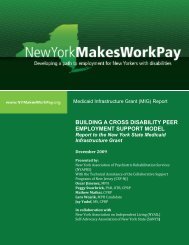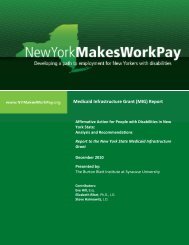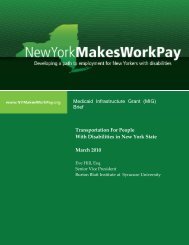Disability & Employment Law in New York State - Cornell University
Disability & Employment Law in New York State - Cornell University
Disability & Employment Law in New York State - Cornell University
You also want an ePaper? Increase the reach of your titles
YUMPU automatically turns print PDFs into web optimized ePapers that Google loves.
<strong>Disability</strong> & <strong>Employment</strong> <strong>Law</strong> <strong>in</strong> <strong>New</strong> <strong>York</strong> <strong>State</strong>:Analysis and Recommendationswhere vacant and appropriate, to <strong>in</strong>dividuals with disabilities who become unable toperform <strong>in</strong> a particular job.Adopt Reasonable Standards of Proof: Recogniz<strong>in</strong>g that employers have greateraccess to <strong>in</strong>formation about job requirements and accommodation possibilities, theNYSHRL should adopt the burden of proof expectations modeled <strong>in</strong> the <strong>New</strong> <strong>York</strong> CityHuman Rights <strong>Law</strong>, requir<strong>in</strong>g employers to prove an applicant or employee isunqualified. In addition, as <strong>in</strong> some other states, the standard for establish<strong>in</strong>g adiscrim<strong>in</strong>atory act should ideally be that disability discrim<strong>in</strong>ation was a factor, ratherthan the primary motivation. This latter measure is important <strong>in</strong> ensur<strong>in</strong>g that <strong>in</strong> “mixedmotive”cases, where disability is not an isolated or sole factor engender<strong>in</strong>gdiscrim<strong>in</strong>ation (but is primarily at issue), that pla<strong>in</strong>tiffs will still have legal protection. 186Strengthen Commitments of <strong>State</strong> Agencies: <strong>State</strong> government employers are underthe same obligations applied to private employers to avoid disability discrim<strong>in</strong>ation.However, government agencies also have additional affirmative action obligations (e.g.,Executive Order 6; Civil Service <strong>Law</strong>s 55b/c). In light of the large size of the stateworkforce, committ<strong>in</strong>g to uphold a higher standard of <strong>in</strong>clusion and equity <strong>in</strong> <strong>New</strong> <strong>York</strong><strong>State</strong> agencies, will strengthen the full <strong>in</strong>clusion of people with disabilities <strong>in</strong> the stateworkforce. Areas for <strong>in</strong>tervention <strong>in</strong>clude a commitment to publicize and provideeducation to workers about disability and accommodation policies, tra<strong>in</strong><strong>in</strong>g for humanresources and middle management on the <strong>in</strong>teractive process, and obligations tomonitor recruitment, retention, and advancement rates attentive to the proportionate<strong>in</strong>clusion of people with disabilities.The Civil Services <strong>Law</strong>s’ exclusive reliance on employer-appo<strong>in</strong>ted physicians as abasis for term<strong>in</strong>ation should be revised, or more closely monitored, <strong>in</strong> order to ensurethat there is adequate recourse, <strong>in</strong> <strong>in</strong>stances where the employer-appo<strong>in</strong>ted physicianmay have a conflict of <strong>in</strong>terest, and/or where additional medical testimony supportsfitness to work. In addition, the Civil Service <strong>Law</strong>s regard<strong>in</strong>g leave time should beexam<strong>in</strong>ed to ensure consistency with the ADA and NYSHRL, both of which requireleave as a reasonable accommodation and both of which require re<strong>in</strong>statement whenan employee is able to return to work follow<strong>in</strong>g leave. The Civil Service <strong>Law</strong>s’ currentone-year cap on leave may violate the ADA and NYSHRL to the extent that leave ofmore than one year is reasonable and necessary.186 In the 7 th circuit, the court of appeals recently held that the ADA does not provide protection <strong>in</strong> suchcases. Serwatka v. Rockwell Automation, Inc., 591 F.3d 957 (7th cir, 2010). While this decision is notb<strong>in</strong>d<strong>in</strong>g <strong>in</strong> <strong>New</strong> <strong>York</strong> <strong>State</strong>, it highlights the importance of establish<strong>in</strong>g clear protections under state law, <strong>in</strong>order to ensure protections not explicitly guaranteed under the ADA.30





